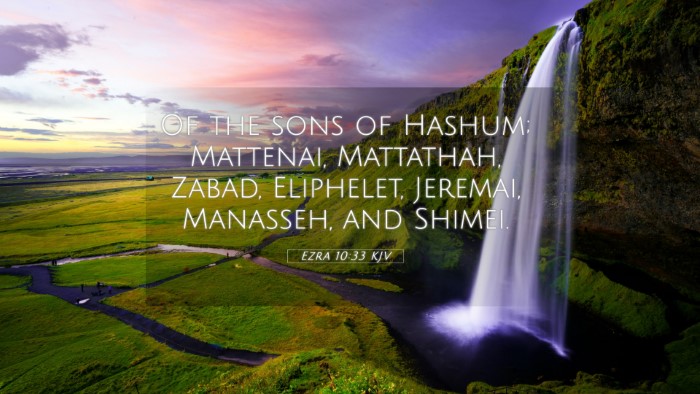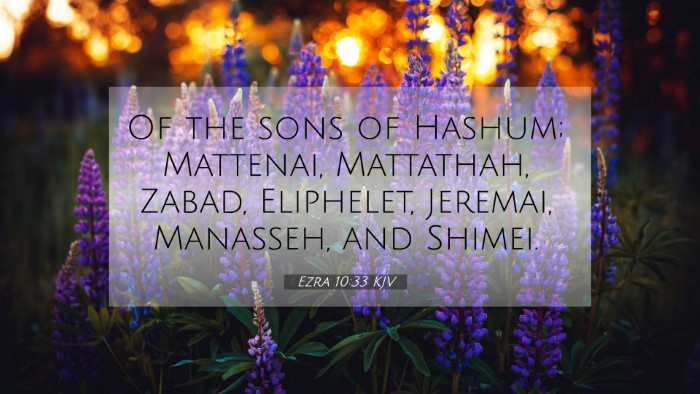Understanding Ezra 10:33
Ezra 10:33 reads: "And of the sons of Jesse; Obadiah, and Joel, and Ahijah: and the sons of Jeroham." This verse is a brief mention of the descendants of certain biblical figures during a significant period of restoration for Israel. The context of this passage is critical for understanding its implications in the wider narrative of Scripture.
Contextual Background
The Book of Ezra narrates the return of the Jewish exiles from Babylon and their efforts to restore the temple and the community. This particular passage, which lists names, highlights the importance of genealogies in showing the continuity of God's people. Genealogies serve as a reminder of God's faithfulness across generations.
Interpretations from Commentators
Commentators such as Matthew Henry, Albert Barnes, and Adam Clarke provide insights into the significance of these names:
- Matthew Henry: He emphasizes the importance of names in the Hebrew culture, noting how they represent not just individuals but the legacy of faithfulness to God. By documenting these names, the author of Ezra illustrates that God's covenant continues through these families.
- Albert Barnes: Barnes focuses on the specific roles these individuals may have played in the restoration of Israel. He stresses that these verses are not merely historical but serve to encourage the community by reminding them of their rich heritage and the active participation of the descendants in the rebuilding efforts.
- Adam Clarke: Clarke provides an analytical view of the names mentioned. He delves into the meanings of the names, linking them to their prophetic implications and highlighting the spiritual significance of their lineage.
Bible Verse Cross-References
This verse has significant connections with various other Scriptures that help deepen our understanding of its message. Notable cross-references include:
- 1 Chronicles 2:13-15: which details the lineage of Jesse, enhancing our understanding of King David's lineage.
- Ezra 2:61-62: discusses the returnees and their genealogy, emphasizing the importance of established family lines.
- Nehemiah 12:10-11: which lists leaders and their families, reflecting the continuity of divine purpose through generations.
- Matthew 1:6: connects the genealogy of Jesus back to David, showing the fulfillment of Messianic prophecies.
- Luke 3:23-38: another genealogy of Jesus that also reflects the importance of ancestry, connecting to both David and other significant figures.
- Hebrews 7:14: mentions Jesus being from Judah, emphasizing the lineage's significance for the Christian faith.
- Romans 11:1: speaks to God’s covenant faithfulness to Israel, paralleling the themes found in Ezra.
Thematic Bible Verse Connections
Exploring the thematic connections in this verse invites insights into God’s ongoing covenant with His people. It showcases:
- God's faithfulness across generations
- The significance of heritage in the community of faith
- The restoration of the Jewish community as a testimony to God’s promises
- The role of names and lineage in biblical narratives
- The fulfillment of God's promises through Jesus Christ as a descendant of these lineages
Tools for Bible Cross-Referencing
Utilizing tools for Bible cross-referencing enhances understanding:
- Bible Concordance: A valuable tool for locating words and themes across Scriptures.
- Bible Cross-Reference Guide: Helps track parallel verses that elaborate on similar themes.
- Bible Chain References: These systems connect verses in a chain format, facilitating deeper study on interconnected themes.
Interpreting Biblical Themes Through Cross-References
In studying passages like Ezra 10:33, we see the value of identifying connections between the Old and New Testaments. This provides a comprehensive understanding of how historical accounts resonate with theological themes, such as redemption, God’s faithfulness, and the unfolding of His plan through history.
User Intent Keywords
This verse is relevant to those seeking to discover:
- Similarities between Old Testament genealogies and New Testament fulfillments
- How these genealogies support doctrine and faith today
- Insights into how to find cross-references in the Bible
- Identifying connections between Old and New Testament
Conclusion
Ezra 10:33, while a short verse, carries a weight of significance within the narrative of God’s people and their history. The connections between Bible verses can illuminate the enduring nature of God’s promise and the rich tapestry of faith illustrated through the genealogy of Jesus and the restoration of Israel.




